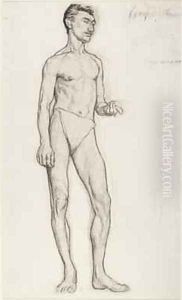Ida Margaret Nettleship Paintings
Ida Margaret Nettleship was a talented British artist, born in 1877 into a family deeply immersed in the artistic and intellectual life of the period. Coming from a background that valued creativity and education, Nettleship showed an early interest and aptitude in art. She honed her skills at the Slade School of Fine Art in London, a leading art institution that was one of the first in England to admit female students. At the Slade, she not only developed her artistic talents but also forged important relationships that would influence her personal and professional life.
Nettleship's artistic career was marked by her dedication to painting and drawing, with her work exhibiting the characteristic detail and emotive quality of the late Victorian and early Edwardian art scenes. Despite her considerable skills and the promise of a successful career in art, her professional life was significantly overshadowed by her marriage to fellow artist Augustus John, whom she married in 1901. Augustus John, who would go on to become one of the foremost British painters of his time, was a charismatic and dominating figure, and his relationship with Ida, while initially full of artistic camaraderie, eventually led to a complex and unconventional marital situation, particularly after John's affair with Dorelia McNeill, who became a lifelong partner to John alongside Ida.
Ida Nettleship's life was characterized by her remarkable resilience and commitment to her family. She bore Augustus John five sons, supporting his career and navigating the challenges of their unconventional family dynamics with strength and grace. Despite the potential for furthering her own career, Nettleship's primary focus shifted towards her family, and her artistic output diminished as she dedicated herself to her children and her often turbulent marriage.
Tragically, Ida Nettleship's life was cut short when she died in 1907 from complications related to childbirth, at the age of 30. Her early death marked the end of a life that was deeply intertwined with the art and cultural movements of her time but also one that was marred by personal sacrifices. In the years following her death, Nettleship's contributions to art and her role in the lives of one of the period's most celebrated artists have been reassessed, with a growing appreciation for the sacrifices she made and the strength she exhibited in the face of personal and professional challenges. Her legacy, while overshadowed by the fame of her husband, remains an important part of the narrative of women in the arts during the late 19th and early 20th centuries.
